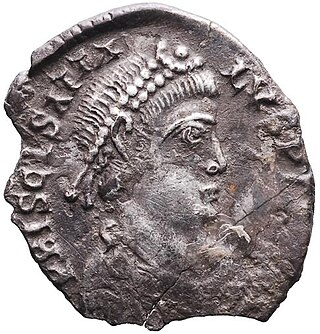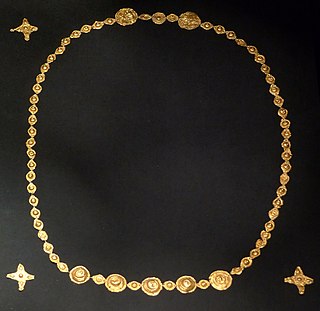The Hasdingi were one of the Vandal peoples of the Roman era. The Vandals were Germanic peoples, who are believed to have spoken an East Germanic language, and were first reported during the first centuries of the Roman empire in the area which is now Poland, eastern Germany, the Czech Republic, and Slovakia.

Year 409 (CDIX) was a common year starting on Friday of the Julian calendar. In the Roman Empire, it was known as the Year of the Consulship of Honorius and Theodosius. The denomination 409 for this year has been used since the early medieval period, when the Anno Domini calendar era became the prevalent method in Europe for naming years.
Year 428 (CDXXVIII) was a leap year starting on Sunday of the Julian calendar. At the time, it was known as the Year of the Consulship of Felix and Taurus. The denomination 428 for this year has been used since the early medieval period, when the Anno Domini calendar era became the prevalent method in Europe for naming years.
Gunderic, King of Hasding Vandals (407-418), then King of Vandals and Alans (418–428), led the Hasding Vandals, a Germanic tribe originally residing near the Oder River, to take part in the barbarian invasions of the Western Roman Empire in the fifth century.

The Vandals were a Germanic people who first inhabited what is now southern Poland. They established Vandal kingdoms on the Iberian Peninsula, Mediterranean islands, and North Africa in the fifth century.
Godigisel (359–406) was King of the Hasdingi Vandals until his death in 406. It is unclear when or how he became king; however, in 405 he formed and led a coalition of Germanic peoples, including the Hasdingi Vandals, Silingi Vandals, Suebi, and others from Pannonia with the intention of invading Roman Gaul. Before crossing the Rhine River into Gaul, he was killed in the Vandal–Frankish war, possibly in late 406. Shortly after his death, this group of Vandals and their allies crossed the Rhine River into the territory of the Roman Empire, possibly while it was frozen.
Foederati were peoples and cities bound by a treaty, known as foedus, with Rome. During the Roman Republic, the term identified the socii, but during the Roman Empire, it was used to describe foreign states, client kingdoms or barbarian tribes to which the empire provided benefits in exchange for military assistance. The term was also used, especially under the empire, for groups of "barbarian" mercenaries of various sizes who were typically allowed to settle within the empire.

Wallia or Walha, was king of the Visigoths from 415 to 418, earning a reputation as a great warrior and prudent ruler. He was elected to the throne after Athaulf and then Sigeric were assassinated in 415.

Tarraco is the ancient name of the current city of Tarragona. It was the oldest Roman settlement on the Iberian Peninsula. It became the capital of Hispania Tarraconensis following the latter's creation during the Roman Empire.
Flavius Castinus held the position of patricius in the court of Roman Emperor Honorius at the time of the Emperor's death, and most likely for some time before. He also served as consul for the year 424.

The Cessetani were an ancient Iberian (Pre-Roman) people of the Iberian peninsula. They are believed to have spoken the Iberian language. Their territory extended along the coast between the Coll de Balaguer and the Garraf Massif and was limited in the west by the Prades Mountains.
Addac or Attaces was king of the western Alans in Hispania. In 409, the Alans settled in the provinces of Lusitania and Carthaginiensis: Alani Lusitaniam et Carthaginiensem provincias, et Wandali cognomine Silingi Baeticam sortiuntur. Some doubt whether the Alans held all or just parts of Carthaginiensis.

Gaiseric, also known as Geiseric or Genseric was king of the Vandals and Alans from 428 to 477. He ruled over a kingdom he established and played a key role in the decline of the Western Roman Empire during the 5th century. Through his nearly fifty years of rule, Gaiseric raised a relatively insignificant Germanic tribe to the status of a major Mediterranean power.
Gerontius was a general of the Western Roman Empire, who initially supported the usurper Constantine III but later opposed him in favour of another usurper, Maximus of Hispania.
This section of the timeline of Hispania concerns Spanish and Portuguese history events from the Carthaginian conquests to before the barbarian invasions.

The Battle of the Nervasos Mountains occurred in the year 419 and was fought between a coalition of Suebi, led by King Hermeric together with allied Roman Imperial forces stationed in the Province of Hispania, against the combined forces of the Vandals and Alans who were led by their King Gunderic. This battle occurred in the context of a contemporary Germanic invasion of the Iberian Peninsula. The battle took place in what is today the Province of León, Spain, and resulted in a Roman/Suebian Victory.

Asterius was a Roman general who obtained the title of comes Hispaniarum in which capacity he participated in an important military expedition against the Vandals who had established themselves in the north of Gallaecia. He was also able to defeat the usurper, Maximus of Hispania who had taken refuge with the barbarian tribes there. Due to his military prowess and his considerable amount of battlefield victories, he was given the title of Patrician in 422.

Carthage was captured by the Vandals from the Western Roman Empire on 19 October 439. Under their leader Genseric, the Vandals crossed the Strait of Gibraltar into Africa and captured Hippo Regius in August 431, which they made the capital of their kingdom. Despite an uneasy peace with the Romans, Genseric made a surprise attack against Carthage in October 439. After capturing Carthage, the Vandals put the city to the sack and made it the new capital of their kingdom.

The Vandal conquest of Roman Africa, also known as the Vandal conquest of North Africa was the conquest of Mauretania Tingitana, Mauretania Caesariensis, and Africa Proconsolaris by the migrating Vandals and Alans. The conflict lasted 13 years with a period of four years of peace, and led to the establishment of the Vandal Kingdom in 435.









